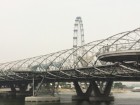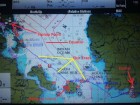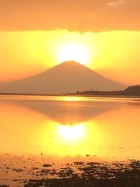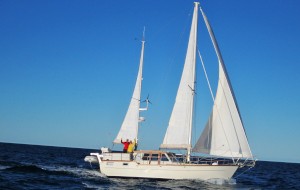Kailana
| Vessel Name: | Kailana |
| Vessel Make/Model: | Nauticat 38 |
| Hailing Port: | Fremantle |
06 November 2014
15. Singapore
Singapore is an amazing city. It is the city that never sleeps, always something going on with a plethora of places to eat, shop and drink. You can buy a cheap meal in a hawkers food stall for $3-5 (Beef Hor Fun quite a good choice) or you can go to a fine dining establishment and feel the need to either [...]
06 November 2014
14. Kumai to Singapore
From leaving Kumai (Borneo) we headed to Pulau Belitung. A distance of 330Nm, which we completed in 51 hours, hence 2x overnighters in a trot - not really our favourite. There was quite a bit of traffic to avoid at night, with both tankers and fishermen dotting our path north and not always on AIS, so [...]
26 October 2014
13. Kumai (Borneo)
We were quite surprised to hear that Sam, our Sail Indonesia agent, had made his way to Kumai. After going AWOL in Bali we basically wrote him off as being of any assistance with our visas, leaving it to a 'proxy' Agent named Ruth to organise the passports to be sent to Nongsa Point, our designated check-out [...]
22 October 2014
12. Java Sea Crossing
In the last blog we were happily sailing away from Bali, safe in the knowledge that our passports and visa extensions were speedily and professionally being processed before being sent ahead of us. Or were they? We had now dropped behind all the rally boats due to the immigration administration slow-boat [...]
07 October 2014
11. Gilli Air & Bali
The last you heard from us we were on our way to Lombok from Sumbawa. We are now back in the company of our other yachties. The crossing to Lombok was easy enough, only being able to sail about half the way. We stayed in a decent enough anchorage on the North East of Lombok, which proved to be a bit [...]
17 September 2014
10. Labuan Bajo to Sumbawa (via Komodo & Rinca Islands)
Indonesia really is a unique place. With a population of about 190 million, it has 300 different ethnic groups living within it, over 13,000 islands, with 580 languages and dialects spoken. That is diversity at its best. Not only does it have the largest population of Muslims, but it also has the [...]
10. Labuan Bajo to Sumbawa (via Komodo & Rinca Islands)
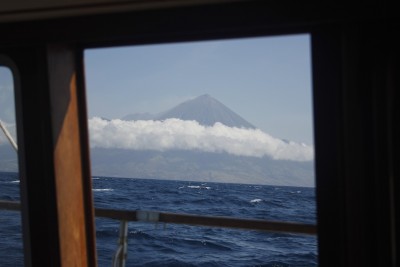
After finally dragging Kev away from his wood fired pizzas , we headed out of Labuan Bajo harbour. We decided to circumnavigate Rinca Island, where we had heard we would get some good 'Komodo Dragon sighting'. Getting the current in your favour can sometimes be a bit of Russian roulette here, and this particular day we seemed to hit the jackpot as we headed down a narrow channel of water between western Flores and eastern Rinca. When we saw the overflows happening, we almost lost our nerve, looking down the channel you could actually see it was down hill a wee bit. But we thought what the hell and off we went....screaming down the channel at 14 knots....that is with 7-8 knots of current in our favour! Definitely a thrill and probably a tad irresponsible, but sometimes you got to jazz it up. There were many whirlpools to work our way through and Kev had a firm grip on the helm as we navigated the 2nm channel. It felt like we were back in the Kimberley!
We had planned to stop on the eastern side of Rinca, however we decided to push onto the most southerly anchorage which would provide some good shelter as it was situated behind a small island. The trip down there however was quite horrific with 3 metre swell and generally just really sloppy seas. We ended up in an area of angry confused seas, 3-4m waves passing this way and that coming at us from all angles, with us getting tossed around like a rubber duck. We were rewarded once anchored safely inside as we had our own little safari happening right off the stern of the boat. We were anchored about 2 boat lengths from the beach and from our outside cockpit we could watch Komodo Dragons (measuring up to 3 metres in length), chickens, wild pigs, goats, monkeys and eagles. We took the dinghy right up close to the beach and we had three Komodo dragons about 2 metres away from us. Rumour has it that many of the dive boats bring chickens for the Komodo Dragons so as to put on a show for the tourists. So...the sound of an outboard engine brings out a komodo or two or three. What we didn't know at the time, is that Komodo Dragons CAN swim, and CAN attack dinghies (much like crocs) so we were a little 'naïve' to this!
Komodo Dragons are the largest living species of lizards, growing up to 3 metres. They can live up to 30 years of age and mainly eat deer. They have been around a long time, only found in Indonesia, on only a handful of islands (apart from in international zoos) and are incredibly prehistoric looking. They have been known to attack humans, but this is rare. Whatever they choose for dinner they will eat everything....bones, hair, the lot. Anyone that has gone missing on these islands, there has never been a trace of them found. We made a move the next day, and almost hit a submerged bommie on the way out...which was not mentioned on any of our charts etc. We had heard that there was really good snorkelling on a bommie in the south-eastern part of the bay.. well this was it! With the engine still running, and Kev at the helm, Rebecca jumped off the boat for a quick snorkel and then Kev had a go. Definitely some of the best snorkelling we had done in Indonesia (at this point). We could have stayed another night but we were conscious that our Indonesian visas were ticking away and soon we would have to get ourselves to Bali so we meandered our way to an anchorage on the western side of Rinca which was well protected and very peaceful. It was a big bay with many different options for anchoring (north, west and south of bay). Rinca is hardly populated at all, so we were 'hassle free' from anyone trying to sell us things which is always nice.
Next stop was 'Pink Beach' which really was pink. Upon arrival into this strong tidal channel just east of Komodo Village on Komodo Island, we were approached by some locals that told us we couldn't anchor and that we would have to pay $15 a night for a mooring. We politely refused his offer and anchored around the corner outside of the channel in front of Pink Beach. The holding was poor so we only managed to stay put due to the amount of chain we had out, as the bottom was mostly just bedrock. There was some good snorkelling around our anchorage, and we were too lazy to follow all the dive boats to where they were dropping off the tourists so we just stayed put. While having a couple of sundowners on the back of the boat, we did notice something quite interesting. A deer on the island of Pink Beach decided to swim to the other side of the channel (about 500 metres) in search of 'what' ...we didn't know. It has been a puzzle how all the islands seem to have a large variety of wildlife on them, other than Komodo Dragons, even the small islands. Perhaps this is the answer? Why don't the Dragons just eat everything up...? Rebecca couldn't take her hands off the binoculars as she watched poor 'Bambi' cross the channel, and was ready to jump in the dinghy at a moments notice to save the deer should it not get to the other side....
We had heard about some good snorkelling to the north of Rinca, so we went up to Sebayur Island, still part of the Komodo group, and found a beautiful spot nestled in a bay, with an Italian owned resort on the other side. We hiked to the top of the island which gave us incredible views across the islands. We did some good snorkelling in the channel (which seems to be where all good snorkelling is found - due to the strong currents churning up the food for the fish). and interestingly enough, the best snorkelling was right in front of the resort! We took the opportunity to check out the resort and have a meal - best part being the drink on the beanbags located on the beach...worst part being the prices. Sagata, Esoterica and Apa Lagi joined us on the second day so we had obligatory sundowners on Sagata that night. Sagata had picked up some guests from Labuan Bajo who were going to cruise with them for a few days and unfortunately a couple days in, one of the guests dropped Sagata's only camera in the water (water resistant but a long way down) and it had ALL their photos on it. Needless to say the 'guest' wouldn't have been overly popular. We suppose Karma hit because not only did the guest lose her sunglasses, they also had all their flights delayed by a day on the way out of Labuan Bajo!
With days ticking away (on our visas) we upped anchor after a couple nights and went to Gill Lawa Laut as we had heard this was to be the primo snorkelling place....and we were NOT disappointed! We were only covering short distances between islands but we happened to have great wind that day and sailed all the way which was nice for a change. The first night we anchored in the deep bay to the south of Gill Lawa Laut and did a drift snorkel in the channel to the north of it - amazing... we saw a manta ray and zillions of different coloured fish. There were so many fish that you almost needed fish wipers on your snorkel mask. There was about 3 knots of current taking us along with it, and with the dinghy rope tied to Kev's foot, we were able to have our transport to help us go back against the current. The next day we anchored to the north on Gill Lawa Laut itself and did another drift snorkel in another channel which proved to be the best snorkelling yet. We saw about 5 manta rays - as close as a couple metres away, and we saw about 5 turtles - about 1 metre away. The fish were great, but nothing could take the shine away from seeing the manta rays which were so big (3m x 2m long) and incredibly majestic looking as they 'fly' past you. You don't want to piss off a manta ray, or any type of stingray, as Steve Irwin found out. We climbed to the top of Gill Lawa Laut and by the end of the day we were somewhat knackered! One of the dive boats anchored in the bay had people doing night dives which was really cool to see, as they all are equipped with torches and it lights up the seabed..an underwater light show. We had a diver come almost under our yacht! Kev was tempted to flush the toilet to let him know we were there!
We motor-sailed to Banta Island which is not worth writing about. Rolly and Bloody Windy. We couldn't head for the southern anchorage as we were heading into strong winds so we opted to stay on the north side of the island, hoping to take shelter from the strong southerly. This wasn't to be the case, and with an anchorage that wasn't recommended due to the steepness of the terrain, we were 'on guard' for most of the night. The wind was going for 0 knots to 30 knots in the blink of an eye, with gusting winds called 'Bullets' coming off the mountain. Not a good recipe for a decent night's sleep.
Once day broke, we couldn't wait to get out of there and head for 'Wera'. Wind was in our favour for most of this 30nm journey and we passed a very impressive Volcano on the way. Wera was to be our first port on the island of 'Sambawa'.
Wera is an interesting stop off, and well needed after fighting current for a few hours getting across from Banta Island. When you pull into the quaint little bay, the first thing you notice are the big boats being constructed on the beach between the houses, with the boat's bow jutting out to the tip of beach and the stern seemingly ending inside someone's kitchen! Phinisi boats have multiple uses but most of the ones we have seen have been used for taking tourists out on dives for days at a time, however it is unlikely these are the real McCoe, like what we saw being built in Wera. The boats have towering twin masts, wooden hulls and up to seven sails. These are traditional Indonesian sailing boats that look like they belong to another era. They are all built by hand, with no drawings, plans, etc, only by experience and the skilled eye of the builder. Skill handed down through many generations.
A little bit of history that we picked up off the internet about the Phinisi boats..... These boats have been designed and built by the Bugis, a seafaring people originating from the island of Sulawesi. The boats were originally used (and still are used) to carry cargo across the Indonesian archipelago. Following the monsoon winds, they sailed from island to island gathering exotic feathers, sandalwood, spices and gold to sell at a significant profit in distant ports like Singapore. After offloading their wares to eager merchants, they would fill their holds with European and Chinese manufactured goods to bring back to their homeland.
For centuries the Bugis travelled as far away as Malacca, Burma, Vietnam and Australia in their two-masted ships. They were not only respected as master seafarers but the Bugis were also greatly feared as pirates. They often plagued early English or Dutch trading ships, namely those of the British East India Company and the Dutch East India Company (the V.O.C.). It is popularly believed these encounters resulted in the European sailors bringing their fear of the “bugi men” back to their home countries. So...funnily enough, this is thought to be where the term "Bogeyman" was created....with parents (such as ours) having told us that the "Bogeyman" was going to get us if we didn't behave. Yeah right.
So what is the connection to the little town of Wera where we happen to be? The Bugis migrated far across the archipelago, and to this day continue to build their ships in their new settlements. Wera is one of only a couple of places in Indonesia where these ships are still built. The one you see in the pictures was already a year in production, with a further 2 years to go.
After Wera we travelled 33.5nm to a tiny little village just north of Kilo at the mouth of a deep inlet which we chose not to go down. The holding was good, but purely stayed there as a stopover. The next day we had a fabulous sail (had the Gennaker up - the spinnaker-like sail) which had us flying! We managed to average 6.9 Knots on our way to our next destination which was at the foothills of Mount Tambora. Keeping close to the coast the entire way, we often had the binoculars out, checking out all the little villages along the way, nestled amongst the palm trees that dotted the coastline. Sambawa is a very rugged place which is really appealing to us both as it is really only visited by the surfers on the south coast and from yachties on the north coast. It is really not a touristy place at all, with little facilities on offer. The people are really lovely and we really enjoyed our next stop which was in a little village called 'Brinta', just around the corner from Karanga. As we neared our anchorage for the night, we had Mount Tambora towering on our port (left) side and Pulao Santonda (Pulao = island), and underwater volcano on our starboard (right) side.
Mount Tambora 'was' 4300 metres high before it erupted in 1815. Now it is half that size with a crater 10 miles in diameter. It's eruption was the largest volcanic outburst in history, spewing out 160 km3 of lava, with a death toll of approximately 72,000 people. The eruption caused global climate anomalies. 1816 became known as the year without a summer because of the effect on North American and European weather. Crops failed and livestock died in much of the Northern Hemisphere, resulting in the worst famine of the 19th century. As a result, it was kind of 'eerie' sailing past it. Just off the coast of Sumbawa is the small island of Pulao Satonda, with a small crater lake. The lake used to be freshwater, but the tsunami that was created by the eruption of Tambora, flooded the lake with seawater and the lake is saline to this day. So with all these interesting things to check out along our way (including a big pod of porpoises to top it off), we finally pulled into Brinta. This is a little fishing village of about 200 odd people, who mainly fish for squid. We had a great time checking out the boats and speaking to the locals. We sat down on the beach with all the local women and their children as the men went out to fish at dusk. The women were very animated and good fun to hang out with. We established the normal 'who was related to who' and answered the many questions that ended in confused looks about us 'not being married?' and 'not having children?'. When we told them that we did 'sort of' have children, in the form of a cat and a dog...they thought this was hilarious given they eat dogs. They insisted that Rebecca should hold one of the babies and get photos taken of them together. Although these people don't end up with the photos, they are mad for having photos taken of their children. In Rebecca's broken Indonesian, she arranged (or thought she had arranged) for a chap to paddle out to our boat early in the morning with some 'fresh squid' once the boats were back in from working all through the night (they leave at 6pm and come back in at 6am). Well, we waited and waited and when we finally realised that there was no fresh squid coming we upped anchor and made our way to 'Pulao Medang'. All in all, Brinta was a lovely stop with good holding, making it much more appealing than the normal stop of 'Karanga'. We also met a fisherman and his mate (a fisherman's friend, hee-hee) who were out on a 3-day excursion to catch fish. On their brand new, but tiny little dugout boat with an outrigger, they would only sleep for 1-hour a night, while snorkel spear fishing with a torch. The boat was prepared with the most rudimentary cooking equipment and seemed to have little compartments with all their bits and bobs to support life.
Pulao Medang was to be our last stop in Sumbawa. We had all the sails up for the first couple of hours and then changed to the Genniker, only for the wind to die. Kev reckons that we are guaranteed to have no wind if we put the sails up, so we are going to try it next time we are at anchor (only joking). Up down, up down go the sails, the wind instruments teasing and laughing at us at each operation. Medang was a little island to the north of Sambawa, with a lagoon and village on the leeward side and a somewhat protected anchorage on the windward side, with low lying coral surrounding the bay. We anchored and immediately went exploring. We hauled the dinghy up the nice sandy beach and once again noticed the phenomenon that baffles us about Indonesian coastlines. There must be a 'lost thong' (flip-flops) epidemic facing the people of Indonesia, as you come across hundreds of washed up thongs on the beaches here. Sometimes it is tempting to walk up and down the beach to see if you can find a matching pair! Surely one of the world's great mysteries? We entered into the coconut tree jungle and found ourselves picking our way through cows and goats to get to the back of the little village. A young lad on a motorcycle who was tearing down the paths between the farms decided that Rebecca needed a lift into town, and that Kev could walk...which seemed fair enough so Rebecca hopped onto the back of a motorcycle and left Kev to walk....to where we weren't quite sure - but hopeful that it would all become very clear soon. No sooner had Rebecca popped out of this labyrinth of fenced farms, did Kev then appear down a path to join her. The locals thought it was pretty funny seeing this white woman on the back of a motorcycle come out of nowhere into the village. The locals were very welcoming and it was a very well run community with a good source of drinking water (a plethora of drinking wells), brightly coloured stilt houses and enough mango, banana and coconut trees to keep you full for several lifetimes. We had a bunch of kids trail about after us who gave us a little dried seahorse and a bunch of fresh mangoes off a tree. The state of a village is often a reflection of how efficient their 'Kepala Desa' (chief) is and clearly Medang's Kepala Desa was a good one, as it was a very clean village and well organised. We worked up a sweat in our walk across the island and had a swim next to the boat when we saw five other boats coming into anchor! It was our old friends 'Sagata', 'Esoterica', 'Akka' and two other yachts we didn't know. As we hadn't seen our friends for a week or so, we all had drinks and dinner on board Esoterica that evening and watched another pretty impressive sunset.
The anchorage proved to be a rolly in the wee hours of the morning, so as soon as it was light we made our way out of the bay with our sights set on Lombok!
